

This document discusses the benefits of induction assisted laser processing. The benefits derive principally from a reduction in temperature gradients that if high give rise to the formation of undesirable phases and significant thermal stresses and can cause cracking. Induction heating can be easily integrated into laser processing machines. Induction assisted processes include laser beam welding (where without it laser beam welding of ferrous materials has been limited to low and medium carbon steels because of problems of cracking). Induction heating allows the laser beam welding of a significantly enlarged spectrum of steels including high carbon and case hardening steels cold work tool steel as well as selective types of cast iron. In conjunction with other techniques it provides entirely new opportunities for the design and manufacture of components. The ledeburidic microstructure produced on cast iron parts by surface melting and subsequent self quenching resulting from laser beam surface remelting is distinguished by excellent resistance against abrasive or lubricated wear. The to-date most commonly used technology TIG-remelting produces a comparably coarse microstructure a rather rough surface and a low asperity with respect to the part contour. The rare industrial installations of laser or electron beam remelting utilize furnace preheating in order to prevent the parts cracking but the through-heating in a furnace keeps the hardness in the remelted layer from reaching its highest possible level produces only marginally improved wear properties over TIG-remelting and involves a difficult part handling. The induction assisted laser surface remelting overcomes these disadvantages by being able to achieve a peak temperature and a temperature gradient just adequate to prevent cracking but that at the same time allow sufficient cooling rate to produce a fine grained microstructure with superior wear resistance. Induction assisted laser surface remelting significantly enhances the performance of heavyduty parts made from cast iron such as camshafts and cam disks rocker arms race ways and guides gates and diffuser or deflector plates etc. The application of the technology on tool steel is possible. Laser applied coatings are distinguished by superior wear performance compared with conventional weld overlays. Yet the excellent wear performance often heavily weighs on the coating’s ductility which in conjunction with a high cooling rate causes cracking. In addition the coating rate in sqin/min or g/min is rather limited. Induction hardening of thin sections hidden surfaces small holes or concave elements of small radius however cannot be done without great difficulty. Laser hardening in contrast can often handle those jobs but is simply not economical. The combination of both technologies induction heating and laser hardening opens up a range of difficult parts for quick and economical case hardening.
View Document (674Kb)
Copyright of ©2006 Fraunhofer Institute IWS Dresden
We make every effort to trace copyright. If inadvertently we have not attributed copyright or attributed it incorrectly, please contact us using our webform or by emailing dlm@ailu.org.uk and we will rectify the situation.
Disclaimer
To view disclaimer details click here